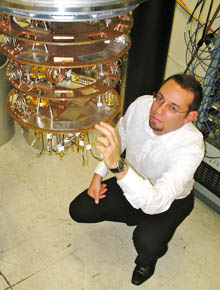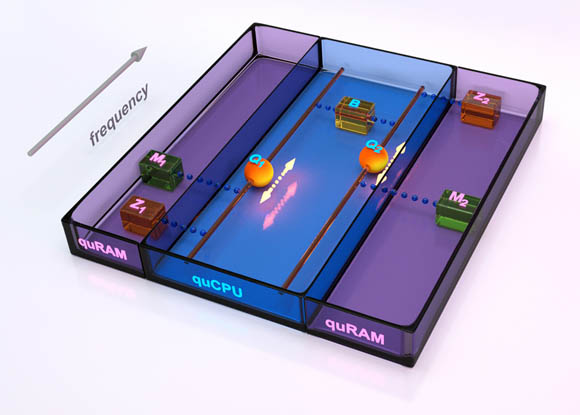This article is more than 1 year old
Boffin melds quantum processor with quantum RAM
Qubits meet John von Neumann
A California physicist has created a quantum-computing chip based on the CPU/RAM combo known as the von Neumann architecture, opening the door, he argues, to commercial quantum-computing development.
"I think it's very exciting as a researcher because we're really at the borderline between the two worlds of physics and engineering," says Matteo Mariantoni, lead author of "Implementing the Quantum von Neumann Architecture with Superconducting Circuits", published on Thursday in the online pre-publication service of Science magazine, ScienceExpress. (You can get 24-hour access to the article for $15.)
In his quantum computer, he says, computational steps take a few billionths of a second, which is about the same as you get with a classical computer. But unlike a classical computer, a quantum computer can handle a large number of these calculations simultaneously.

Matteo Mariantoni and his quantum computer
As Mariantoni explains in a video provided by the University of California at Santa Barabara, where he is a postdoctoral fellow, the two central quantum phenomena upon which quantum computing are based are superposition and entanglement.
In a classical computer, a bit is either zero or one. In a quantum computer, on the other hand, the quantum superposition phenomena enables that bit to be simultaneously both zero and one. Or it can be any mixture of zero and one, such as 30 per cent zero and 70 per cent one.
Not only can each individual qubit be both zero and one or any mixture of the two, but two qubits together can take advantage of quantum entanglement. Mariantoni says that entanglement is "pretty much the same idea as the superposition principle. However, whereas the superposition principle works at the level of a single qubit, this entanglement is the same idea but between two qubits, so you can superimpose, you can mix together, two qubits."
Chillin' at the quantum level
Mariantoni's experiment, of course, doesn't involve only one particle per qubit. Instead, he said, his team used "millions or trillions" of particles to make a single qubit – what he referred to as "an immense sea of electrons that are coherently moving together." That "sea" on a single slice of silicon needed to be supercooled in order to remove the noise produced by energetic, warm, electrons before the quantum-mechanical coherence could be achieved.
That super-cooled chip became the site of Mariantoni's quantum-computing breakthrough. "We've created a quantum CPU," he explains, "where two qubits can interact with each other via a quantum bus – so-called quantum bus – allowing us to make a gate, quantum-entangling gate, and this is your central processing unit. We call it the quCPU."
Mariantoni and his team did more than simply create a quCPU – they engineered a quantum-computing system based on the von Neumann architecture, the scheme developed in the mid-1940s by John von Neumann and revealed in the famous "First Draft of a Report on the EDVAC", a seminal paper familiar to any CompSci student.
At it's core – and ludicrously simplified – the von Neumann architecture essentially describes the structure of every one of today's computers: a CPU/RAM system in which the memory feeds data and instructions to the CPU, and the CPU stores and retrieves the results of its computation in and out of RAM.

The quantum von Neumann machine couples two qubits to a quantum bus, creating a "quCPU." Each qubit has its own quantum memory and a zeroing register, which constitute the "quRAM." (click to enlarge)
The same architecture can benefit a quantum computer. "Once you manage to create quantum information between your two qubits, for example, you want to store it somewhere to reuse it later on for some other computation," he says. "And so we have developed on the same chip the ability to create information and to store it, write it, exactly as in a classical hard disk, in a quantum memory."
In a quantum system, one reason the memory is so important is that it can allow information to hang aroud. "[Quantum memory] is long-lived," Mariantoni explains, "so basically it lives longer than the qubits, so we can store it there for pretty much long times, compared to the lifetime of the qubits, and when we need it later on, we can reread it from the memory, and bring it out and reuse it again for the next step of the quantum calculation."
It's time to open industry wallets
From Mariantoni's point of view, the ability to build a complete quantum von Neumann architecture system on a chip is a major step in moving quantum computing out of the lab and into industry – even if the system he and his team assembled is quite rudimentary and requires supercooling in order to function.
"I think at this point," he says, "being able to put together separate qubits, and quantum memories, and quantum zeroing registers, I think we should call ourselves quantum engineers. A couple of years ago, we were really quantum researchers."
He likens the state of today's quantum devices to where transistors were in the 1950s – the subjects of research studies, not engineering projects. But once the transistor matured, he says, industry took over, and classical computers arrived.
Quantum computing may still be far from being a viable commercial process, but Mariantoni argues that it's time to get going. "We can ... create something that is very close to a classical processor, and we can use it for implementing pretty complicated quantum softwares," he argues. "My feeling is that, at this stage – and it's really true – industries will be interested in investing money and effort in developing a large-scale quantum computer."
He may be right. With the increasing complexity and cost of shrinking silicon-transistor features in classical computing manufacturing, the possibility of commercial quantum computing is compelling – even if there remains a tremendous amount of work to be done by both researchers and engineers.
Just like there was in the years between Shockley, Bardeen, and Brattain's first demonstration of a transfer resistor in late 1947, and Texas Instrument's marketing of the first commercial silicon transistor in 1954. ®
